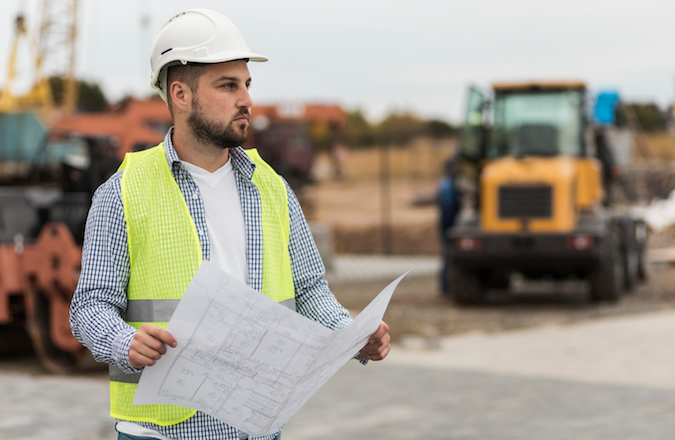In 2006 the Labour government announced the ‘Code for Sustainable Homes’. This committed that from 2016 all new houses would be ‘zero carbon’ and would generate as much energy on-site, as they would use in heating, hot water and lighting [1]. Subsequently in 2008 the Climate Change Act was introduced in the UK, establishing a target of cutting carbon emissions by 80% before 2050. However, while Boris Johnson states we are still on-track for the 2050 target, the zero carbon homes plan has not come to fruition [5].
 Figure 1: Man wearing helmet. [8]
Figure 1: Man wearing helmet. [8]
Failures Within the Proposal
The 2006 ‘Code for Sustainable Homes’ quickly became outdated, with many developers finding loopholes in the system that allowed for sub-par buildings. Large family homes also provided the developers with a healthier profit over building small homes and bungalows, leading to low stock of first-time housing [5].
Several other issues were also raised about the targets, including:
-
- On an annual basis new homes only account for 1% of the total housing stock, therefore the proposed measures would take a long time to have a significant impact on carbon emission levels.
- It may be easier for developers to adopt sustainable practices rather than meet full carbon compliance standards.
- The proposed plan does not consider the carbon emissions resulting from the construction of the homes themselves.
- There is no clear plan for the long-term maintenance or future alterations of the new dwellings.
- If the time frame is realistic.
- Concerns over the impact the new measures will have on the delivery rate of new homes [7].
The last ultimately having the biggest impact in the proposed zero carbon homes plans [2].
Housing Delivery vs Zero Carbon Homes?
In 2015 the government published a plan titled ‘Fixing the foundations: creating a more prosperous nation’, aimed at increasing the productivity of the UK. Within this plan, the deliverability of much needed new housing took a forefront, and the delivery zero carbon homes was stalled [2]. The following statement was also published:
‘The government does not intend to proceed with the zero carbon Allowable Solutions carbon offsetting scheme, or the proposed 2016 increase in on-site energy efficiency standards, but will keep energy efficiency standards under review, recognising that existing measures to increase energy efficiency of new buildings should be allowed time to become established.’ [4]
In a 2014 study undertaken for Energy Policy, UK homebuilders were asked to identify barriers and challenges for the zero-carbon homebuilding. Economic barriers were identified as the most significant, as even with government grants, the profit margins were healthier when building homes that did not meet the zero carbon homes criteria. These higher costs then also produced a knock-on effect as zero carbon homes became less desirable due to a higher purchase price [3]. These barriers lead to less homes being built and the overall stock on new houses plummeting. In 2015 the government stated that 1 million homes needed to be built by 2020, a target that could not be met under the ‘Code for Sustainable Homes’ [6].
So, What Next for Zero Carbon Homes?
In 2016 the ‘Code for Sustainable Homes’ was scrapped with the UK Green Building Council calling it the “death” of zero carbon homes [5]. Policy for zero carbon homes is still on the table as there is still a requirement for the UK to cut carbon emission by 80% before 2050. However, this time the policy needs to be more robust and account for the ever-changing population.
About Pager Power
Pager Power undertakes technical assessments for developers of renewable energy projects and tall buildings. For more information about what we do, please get in touch.
References
[1] Department for Communities and Local Government, 2006. Building a Greener Future: policy statement.
[2] Designingbuildings.co.uk. 2021. Zero carbon homes. (online)
[3] Heffernan, E., Pan, W., Liang, X. and de Wilde, P., 2015. Zero carbon homes: Perceptions from the UK construction industry. Energy Policy, 79, pp.23-36.
[4] London: HM Government. Fixing the foundations. 2015
[5] the Guardian. 2021. UK scraps zero carbon homes plan. (online)
[6] UK Parliament, 2021. Tackling the under-supply of housing in England. House of Commons Library.
[7] UK Parliament, 2016. Zero Carbon Homes. House of Commons Library.
[8] Last accessed on March 28th 2022. Available at: https://www.freepik.com/free-photo/medium-shot-man-wearing-helmet_11106660.htm#page=2&query=builders&position=41



